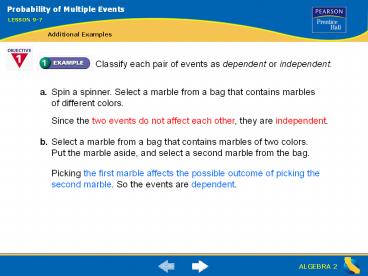Inverse Variation - PowerPoint PPT Presentation
1 / 7
Title:
Inverse Variation
Description:
Title: Inverse Variation Last modified by: tyoung Document presentation format: On-screen Show Company: Pearson Inc. Other titles: Times Arial Black Arial Verdana Geo ... – PowerPoint PPT presentation
Number of Views:177
Avg rating:3.0/5.0
Title: Inverse Variation
1
Probability of Multiple Events
LESSON 9-7
Additional Examples
Classify each pair of events as dependent or
independent.
a. Spin a spinner. Select a marble from a bag
that contains marbles of different colors.
Since the two events do not affect each other,
they are independent.
b. Select a marble from a bag that contains
marbles of two colors. Put the marble aside,
and select a second marble from the bag.
Picking the first marble affects the possible
outcome of picking the second marble. So the
events are dependent.
2
Probability of Multiple Events
LESSON 9-7
Additional Examples
A box contains 20 red marbles and 30 blue
marbles. A second box contains 10 white marbles
and 47 black marbles. If you choose one marble
from each box without looking, what is the
probability that you get a blue marble and a
black marble?
3
Probability of Multiple Events
LESSON 9-7
Additional Examples
(continued)
4
Mutually Exclusive Formulas
- Probability of (A or B)
- Mutually Exclusive means that it is not possible
for two events to happen at the same time. - If A and B are mutually exclusive events, then
- P (A or B) P(A) P(B)
- If A and B are not mutually exclusive events,
then - P(A or B) P(A) P(B) P(A and B)
5
Probability of Multiple Events
LESSON 9-7
Additional Examples
Are the events mutually exclusive? Explain.
a. rolling an even number and rolling a number
greater than 5 on a number cube
By rolling a 6, you can roll an even number and a
number greater than 5 at the same time. So the
events are not mutually exclusive.
b. rolling a prime number or a multiple of 6 on a
number cube
Since 6 is the only multiple of 6 you can roll at
a time and it is not a prime number, the events
are mutually exclusive.
6
Probability of Multiple Events
LESSON 9-7
Additional Examples
At a restaurant, customers get to choose one of
four vegetables with any main course. About 33
of the customers choose green beans, and about
28 choose spinach. What is the probability that
a customer will choose beans or spinach?
Since a customer cannot not choose both beans and
spinach, the events are mutually exclusive.
P(beans or spinach) P(beans) P(spinach) Use
the P(A or B) formula for mutually
exclusive events.
0.33 0.28
0.61
The probability that a customer will choose beans
or spinach is about 0.61 or about 61.
7
Probability of Multiple Events
LESSON 9-7
Additional Examples
A spinner has twenty equal-size sections
numbered from 1 to 20. If you spin the spinner,
what is the probability that the number you spin
will be a multiple of 2 or a multiple of 3?
P(multiple of 2 or 3) P (multiple of 2) P
(multiple of 3) P (multiple of 2 and 3)































